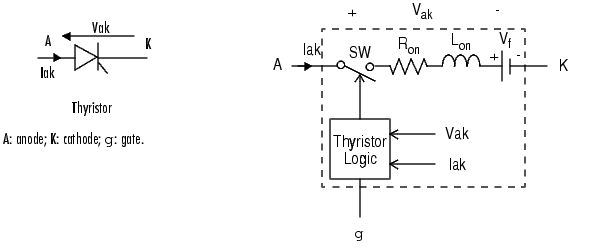

| Power System Blockset |   |
Library
Description
A Thyristor is a semiconductor device that can be turned on via a gate signal. The thyristor model is simulated as a resistor (Ron), an inductor (Lon), and a DC voltage source (Vf), connected in series with a switch. The switch is controlled by a logical signal depending on the voltage Vak, the current Iak and the gate signal (g).

The Thyristor block also contains a series Rs-Cs snubber circuit that can be connected in parallel with the thyristor device.
The static VI characteristic of this model is shown in figure below.
The thyristor device turns on when the anode-cathode voltage is greater than Vf and a positive pulse signal is applied at the gate input (g>0). The pulse height must be greater than zero and last long enough to allow the thyristor anode current to become larger than the latching current Il.
The thyristor device turns off when the current flowing in the device becomes zero (Iak=0) and a negative voltage appears across the anode and cathode for at least a period of time equal to the turn-off time Tq. If the voltage across the device becomes positive within a period of time less than Tq, the device will turn on automatically even if the gate signal is low (g = 0) and the anode current is less than the latching current. Furthermore, if during turn on, the device current amplitude stays below the latching current level specified in the dialog box, the device turns off after the gate signal level becomes low (g = 0).
The turn-off time Tq represents the carrier recovery time: it is the time interval between the instant the anode current has decreased to zero and the instant when the thyristor is capable of withstanding positive voltage Vak without turning on again.
Thyristor Model and Detailed Thyristor Model
In order to optimize simulation speed, two models of thyristors are available: the thyristor model and the detailed thyristor model. For the thyristor model, the latching current Il and recovery time Tq are assumed to be zero.
 ). The Resistance Ron parameter cannot be set to
). The Resistance Ron parameter cannot be set to 0 when the Inductance Lon parameter is set to 0.0 when the Resistance Ron parameter is set to 0. ). Set the Snubber resistance Rs parameter to
). Set the Snubber resistance Rs parameter to inf to eliminate the snubber from the model. 0 to eliminate the snubber, or to inf to get a purely resistive snubber.Inputs and Outputs
The Thyristor block consists of two inputs and two outputs. The first input and output are the thyristor terminals connected respectively to anode (a) and cathode (k). The second input (g) is a Simulink logical signal applied to the gate. The second output (m) is a Simulink measurement output vector [Iak, Vak] returning the thyristor current and voltage.
Assumptions and Limitations
The Thyristor block implements a macro-model of the real thyristor. It does not take into account either the geometry of the device or complex physical processes that model the behavior of the device [1-2]. The forward breakover voltage and the critical value of the derivative of the reapplied anode-cathode voltage are not considered by the model.
Depending on the value of inductance Lon, the Thyristor block is modeled either as a current source (Lon>0) or as a variable topology circuit (Lon=0). See Advanced Topics chapter for more details.
As the Thyristor block is modeled as a current source, it cannot be connected in series with an inductor, a current source or an open circuit, unless a snubber circuit is used.
You must use a stiff integrator algorithm to simulate circuits containing thyristors. Ode23tb or Ode15s with default parameters usually give best simulation speed.
The inductance Lon will be forced to zero if you choose to discretize your circuit.
Example
A single pulse thyristor rectifier is used to feed a RL load. The gate pulses are obtained from a pulse generator synchronized on the source voltage. The circuit is available in the psbthyristor.mdl file. The following parameters are used:
R=1 ; L=10mH; Thyristor block: Ron=0.001
; L=10mH; Thyristor block: Ron=0.001  , Lon=0 H, Vf=0.8 V, Rs=20
, Lon=0 H, Vf=0.8 V, Rs=20  , Cs=4e-6 F.
, Cs=4e-6 F.
The firing angle is varied by a pulse generator synchronized on the voltage source. Run the simulation and observe the load current, load voltage, as well as the thyristor current and voltage.
References
[1] Rajagopalan, V., Computer-Aided Analysis of Power Electronic Systems, Marcel Dekker, Inc., New York,1987.
[2] Mohan, N., Power Electronic, Converters, Applications and Design, John Wiley & Sons, Inc., New York, 1995.
See Also
Diode, Universal Bridge
 | Three-Phase Transformer (Three Windings) | Universal Bridge |  |